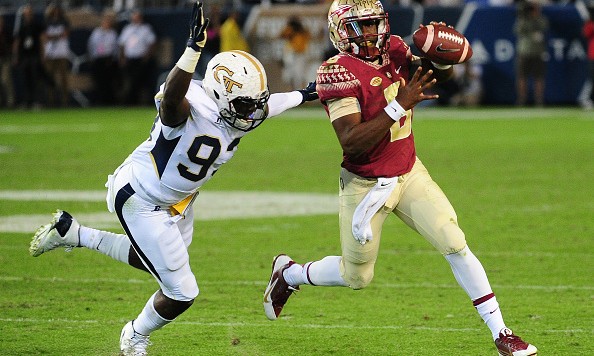Field goals inside the red zone are some of the most frustrating things for both fans and coaches of football teams. Often times, games are won and lost depending on the choices made inside the opponents’ 20-yard-line, especially games where possession time becomes a serious consideration.
The 2015 season has emphasized this many times already — look at Tennessee’s losses to Oklahoma and Florida for a thorough argument on why teams should try and maximize their scoring opportunities when they’re close to an opponent’s end zone.
Florida State and Jimbo Fisher seem to have not gotten this memo. The Seminoles have had 25 red zone scoring opportunities on the year, and they have scored touchdowns on only 12 of those opportunities. Roberto Aguayo and his skills have covered up this issue for the first few games, but it was on full display against after Georgia Tech on Saturday night as the Seminoles managed just a single touchdown in four red zone trips in a 22-16 loss. It’s Lance Austin’s 78-yard blocked field goal return for a touchdown that will be remembered, but not converting in the red zone may have been just as costly.
Not many people will deny that FSU dominated the first half. It allowed a long touchdown from Georgia Tech quarterback Justin Thomas, but aside from that, the team was firing on almost all cylinders. Instead of heading into halftime up by at least two scores, the Seminoles had a mere 6-point lead on the road against a team known to cause issues with its triple-option offense. The defense did its part. This loss isn’t on them.
This issue has been around all season. A breakdown of FSU’s play calling in these positions seems to reveal a trend: When inside the red zone, the Seminoles become decidedly more conservative. Out of 394 combined passing and running plays, FSU has attempted 185 passes. That comes out to around 47 percent of all offensive plays. While inside the red zone? 40 percent (26 of 65). The ‘Noles are deciding to hit the ground more often in hopes that they can push their way in for a touchdown.
On the surface, this seems rational. After all, they have one of the best running backs in the nation in Dalvin Cook and no true threats at wide receiver. Quarterback Everett Golson also had issues with turnovers in the red zone last year with Notre Dame, so FSU head coach Jimbo Fisher might be trying to limit the risks he takes.
But passing seems to be a much more effective tool for scoring than running. Florida State has had five red zone touchdowns from running the ball compared to seven touchdowns and an interception when passing. That’s keeping in mind the fact that run plays have had many more opportunities to do so.
Not all of this issue should be pinned on the skill players however. The offensive line has had seven penalties in the red zone — a combination of false starts and holding calls that make it much more difficult for an offense to score. This also means that FSU has to pass more to regain the yardage, a realization that probably makes the percentage breakdown look better than it is.
How much blame goes to Fisher is unclear. Some of it is certainly players not executing good play calls, like Golson missing open receivers or the offensive line not getting enough push against mediocre defensive lines. But after five and half years of coaching the Seminoles, there’s been a few games where Fisher’s conservatism has cost the team dearly; the Georgia Tech loss on Saturday qualifies as one of those games.
On the second offensive drive against the Yellow Jackets, FSU was facing fourth down at the 2(!)-yard-line. The Seminoles chose to bring on Aguayo for the field goal. In a game where touchdowns mattered, FSU could have went for the end zone and forced Georgia Tech to go 98 yards if it failed. The Seminoles went a different route, which may have been costly when all was said and done.
There’s no denying that Fisher is a great coach. A 64-12 record with three ACC championships and a national title speaks volumes. There have however been times where he’s been scrutinized for being too conservative. Many may look back on Saturday night as one of those times.
Perhaps this game will be the one that forces FSU to rethink its strategy in the red zone, but history tells us that probably won’t be happening. Against teams like South Florida or Miami, it does not really decide games as much because those are not teams with offenses known to take advantage of missed scoring opportunities. Against Clemson or Georgia Tech however, it will kill you.
That is exactly what happened on Saturday night in Atlanta.




















